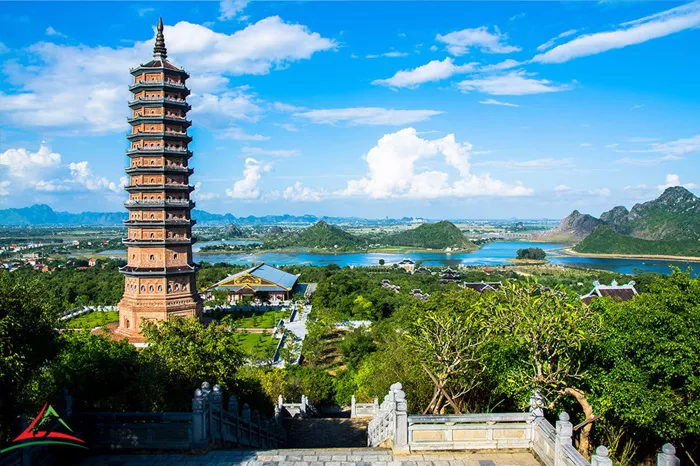Bai Dinh Temple is one of the largest and most famous Buddhist temples in Vietnam. It is located in Ninh Binh province, in the northern part of the country. This temple is well-known for its peaceful atmosphere, beautiful architecture, and deep spiritual meaning. For many visitors and believers, Bai Dinh is a sacred place to pray, meditate, and learn about Buddhism.
Historical Origins of Bai Dinh Temple
Early Beginnings
The original Bai Dinh Temple was built many centuries ago, during the 10th century under the Dinh dynasty. It was first a small temple dedicated to the Buddha and local spirits. Over time, the temple became a popular pilgrimage site for Buddhists. The old temple, now called the ancient Bai Dinh, holds great historical importance and is still preserved today.
Modern Expansion
In the early 2000s, a large new complex was built around the ancient temple to accommodate growing numbers of pilgrims and tourists. This modern section is often called the New Bai Dinh Temple. It includes many large halls, statues, and gardens. The construction of the new temple was guided by traditional Buddhist principles combined with modern design techniques. The expansion helped Bai Dinh become a national symbol of Vietnamese Buddhism.
Architectural Features of Bai Dinh Temple
Layout and Design
The temple complex covers an area of over 700 hectares. It is carefully designed to create harmony between nature and spiritual space. The layout follows Buddhist architecture principles, such as balance, symmetry, and connection to natural elements. Visitors enter through a grand gateway, which leads to large courtyards, meditation halls, and pagodas.
Key Buildings and Structures
Main Hall: The main prayer hall is vast and houses a giant statue of the Buddha. The hall is decorated with intricate carvings and traditional motifs that symbolize Buddhist teachings.
Bell Tower and Drum Tower: These towers are typical in Buddhist temples. At Bai Dinh, the bell and drum towers are enormous, with one of the largest bronze bells in Southeast Asia weighing over 36 tons.
Statues: Bai Dinh is famous for having hundreds of statues of Buddhas, bodhisattvas, and other important Buddhist figures. The largest bronze Buddha statue is a remarkable sight and represents peace and enlightenment.
Use of Materials and Techniques
The builders used a mix of traditional materials such as wood and stone, alongside modern concrete and bronze for durability. Carving and painting techniques are traditional, showing skilled craftsmanship passed down through generations. The decorations include lotus flowers, dragons, and clouds, all common symbols in Buddhist art.
Cultural and Spiritual Value of Bai Dinh Temple
A Place for Pilgrimage and Worship
Bai Dinh Temple is a major pilgrimage destination for Buddhists from Vietnam and abroad. Many visit during important Buddhist festivals, such as Vesak and the Lunar New Year. The temple offers a place for prayer, meditation, and reflection. It supports the practice of Buddhism by providing monks and visitors with spiritual teachings.
Preserving Vietnamese Buddhist Traditions
The temple plays an important role in preserving traditional Buddhist culture in Vietnam. It hosts rituals, ceremonies, and educational programs about Buddhist philosophy and ethics. Bai Dinh helps keep the connection alive between modern Vietnamese people and their Buddhist heritage.
Tourism and Education
Besides being a spiritual site, Bai Dinh Temple is also a cultural landmark. Tourists come to admire the temple architecture and learn about Buddhism. The temple area includes museums and exhibition spaces that explain the history of Buddhism in Vietnam. This makes Bai Dinh a center for cultural exchange and education.
How Bai Dinh Temple Reflects Buddhist Architecture
Symbolism in Design
Buddhist architecture always emphasizes symbolic meaning. Bai Dinh Temple is no exception. The number of statues, the shape of roofs, and the arrangement of spaces all reflect Buddhist ideas like the path to enlightenment, the cycle of life, and compassion. The use of light, space, and nature creates a feeling of calm and sacredness.
Integration with Nature
Many Buddhist temples, including Bai Dinh, are built in harmony with their natural surroundings. Trees, mountains, and water are part of the temple environment. This shows the Buddhist teaching of respect for all living things and the connection between humans and nature.
Conclusion
Bai Dinh Temple is more than just a religious building. It is a place that connects history, culture, art, and spirituality. Its rich history and grand architecture invite people to explore and understand the depth of Buddhist teachings. For anyone interested in Buddhism, visiting Bai Dinh is a powerful experience that combines peace, beauty, and wisdom.

